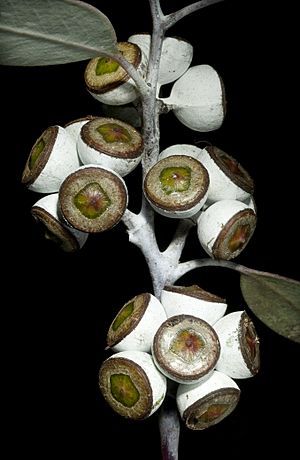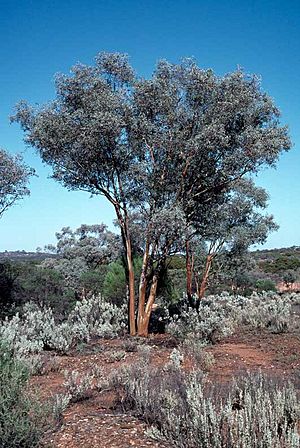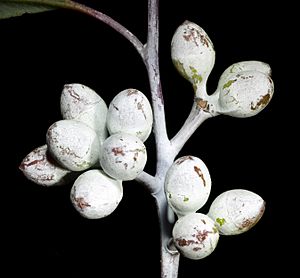Silver gimlet facts for kids
Quick facts for kids Silver gimlet |
|
|---|---|
 |
|
| Eucalyptus campaspe fruits | |
| Scientific classification | |
| Genus: |
Eucalyptus
|
| Species: |
campaspe
|

The Eucalyptus campaspe, often called the silver gimlet or silver-topped gimlet, is a special kind of tree. It only grows in Western Australia, meaning it is endemic there. This tree has smooth, shiny bark and long, thin adult leaves. Its flower buds grow in groups of seven, and its flowers are white. The fruit looks like a cup or cone.
Contents
What Does the Silver Gimlet Look Like?
The silver gimlet is a tree or a small, tree-like plant called a mallet. It usually grows to be about 3 to 11 meters (10 to 36 feet) tall. It has very smooth, shiny bark that can be silver or even coppery in color. The stems of this tree often look twisted. Unlike some other trees, it does not form a lignotuber, which is a woody lump at the base that helps plants regrow after fires.
Leaves of the Silver Gimlet
Young silver gimlet plants, or new shoots that grow back, have lance-shaped or egg-shaped leaves. These leaves are about 50 to 80 millimeters (2 to 3 inches) long and 15 to 35 millimeters (0.6 to 1.4 inches) wide. They are covered with a powdery white coating.
The adult leaves are arranged one after another along the stem. They are lance-shaped, about 70 to 120 millimeters (2.8 to 4.7 inches) long and 8 to 25 millimeters (0.3 to 1 inch) wide. These leaves grow on a stalk called a petiole, which is about 7 to 25 millimeters (0.3 to 1 inch) long. Adult leaves start out dull and a blue-green color, but they become shiny as they get older.
Flowers and Fruit of the Silver Gimlet
The flower buds of the silver gimlet grow in groups of seven. They are found in the axils of the leaves, which is the angle between a leaf and the stem. These groups of buds are on a flat stalk called a peduncle, about 5 to 15 millimeters (0.2 to 0.6 inches) long. Each individual bud has its own small stalk, called a pedicel, which is 1 to 4 millimeters (0.04 to 0.16 inches) long.
Mature flower buds are oval-shaped, about 9 to 12 millimeters (0.35 to 0.47 inches) long and 6 to 10 millimeters (0.24 to 0.39 inches) wide. They have a blue-green, powdery look and a cone-shaped cap called an operculum. The silver gimlet flowers are white and bloom between January and March.
After flowering, the tree produces fruit. This fruit is a woody capsule that is also blue-green and powdery. It is shaped like a cup, half-sphere, or cone, about 6 to 9 millimeters (0.24 to 0.35 inches) long and 8 to 10 millimeters (0.31 to 0.39 inches) wide. The fruit has a wide disc and valves that stick out.
How the Silver Gimlet Got Its Name
The Eucalyptus campaspe was first officially described by a botanist named Spencer Le Marchant Moore in 1899. He wrote about it in a scientific paper called The Botanical Results of a Journey into the Interior of Western Australia. The first sample of the tree, known as the type specimen, was collected by Moore in 1895 near Gibraltar in the Goldfields area of Western Australia.
The special name for the species, campaspe, comes from Campaspe, who was a famous person in ancient history. However, the exact reason why this tree was named after her is not known.
Other Gimlet Trees
The Eucalyptus campaspe is one of six types of "true gimlet" trees. These trees are special because their flower buds always grow in groups of seven. The other true gimlet species include E. ravida, E. effusa, E. salubris, E. terebra, and E. tortilis.
You can tell E. salubris apart from E. ravida and E. campaspe because E. salubris does not have the powdery blue-green branches that the other two do.
Where the Silver Gimlet Grows
The silver gimlet tree is found on rocky hillsides and flat areas in the Goldfields-Esperance region of Western Australia. It grows between the towns of Kalgoorlie and Norseman. This tree prefers sandy-loam-clay soils.
It often grows as part of low woodland communities on flat plains that have a lot of lime in the soil, or on flat areas near rivers. Other trees that often grow with the silver gimlet include E. salubris, E. gracilis, and sometimes E. salmonophloia and Casuarina cristata.
Many shrubs also grow in these woodlands, such as Santalum acuminatum, Atriplex vesicaria, Atriplex nummularia, and different kinds of Eremophila and Dodonaea. Some of the smaller plants that grow on the ground in these areas are Plantago debilis, Helipterum strictum, Gnephosis brevifolia, Ptilotus exaltatus, and Senecio glossanthus.


